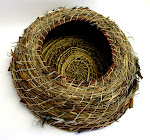Still recovering from my huge weekend in Bangkok! Managed to catch a load of great exhibitions and of course, didn't see half of what I wanted to.
One of the highlights of the weekend was Cambodian artist
Sopheap Pich's exhibition
Tidal at
H Gallery. Beautiful, large-scale rattan pieces that made me want to jump inside them. I was particularly interested in the references to Khmer history and society and the connection between to the artworks and Sopheap's experience of surviving genocide to become a refugee as a child, moving to the US, and then returning to Cambodia as an adult.

This piece was inspired by Tonle Sap and it's unique tidal system (at different times of the year, water flows both down and upstream from the lake). There was also a fabulous installation of rattan dogs which appeared to be partly submerged in water; a nice play on perspective using the gallery wall to represent the surface of the water.

Another highlight of the weekend was Confectionaries and Conurbations an exhibition which an old mate of mine Steve Pettifor has recently curated. Fabulously colourful and playful work by 2 female, Asian, disaporic artists - Tiffany Chung and Chila Kumari Burman.
100 Tonson Gallery is one of my favourite Bangkok galleries (largely because of the exhibitions and artists they choose to represent and also because it is one of the few galleries not inside a Bangkok shopping mall!); definately worth a look if you are in Bangkok.
 Steve Pettifor and I arrived in Bangkok around the same time in 1992 and became part of a circle of friends. While I have jumped in and out of the kingdom in the time since then, he has remained firmly on Thai soil and has carved out a niche for himself as a Bangkok-based art writer and curator. A few years back he published the text Flavours - Thai Contemporary Art which gives a good overview of some of the more recognised Thai artists. He puts together a monthly Bangkok Art Map (BAM) which can be picked up in galleries around town - a great publication to get your hands on as just so much art to check out in Bangkok. Great to catch up with him after a number of years; he gave an informative talk to my students about curatorial and art-writing work and the artists represented in Confectionaries and Conurbations.
Steve Pettifor and I arrived in Bangkok around the same time in 1992 and became part of a circle of friends. While I have jumped in and out of the kingdom in the time since then, he has remained firmly on Thai soil and has carved out a niche for himself as a Bangkok-based art writer and curator. A few years back he published the text Flavours - Thai Contemporary Art which gives a good overview of some of the more recognised Thai artists. He puts together a monthly Bangkok Art Map (BAM) which can be picked up in galleries around town - a great publication to get your hands on as just so much art to check out in Bangkok. Great to catch up with him after a number of years; he gave an informative talk to my students about curatorial and art-writing work and the artists represented in Confectionaries and Conurbations.

Also caught a great show of contemporary Indian art Here and Now at Soulflower gallery and Chiang Mai-based Kamin Lertchaiprasert's latest offerings at Tang Contemporary Art Gallery. Some fabulous work.
An exhibition I really enjoyed was Hoopla Loop at Art Republic, a colourful exhibition of 3 young Chaing Mai artists, Luck Maisalee, Artid Poonyasiri and Torlarp Larpjaroensuk.
Unfortunately the weekend was cut short by a horrible bout of Leptospirosis (yes, the rat urine disease!) as a friend who was with me had to be hosptalised after catching this nasty bug on a white water rafting trip the previous weekend. So, I spent the next few days check out the watercolours which wallpaper the halls of Bumrungrad Hopsital in Bangkok.... anyway, this trip reminded me what an exciting city for contemporary Asian art Bangkok is and I have started making plans for another trip in a few weeks.
 Since reading more about the recent political crackdown in Burma and the censorship of art, I have been thinking about red and how much I take for granted colour and the freedom to use colour. At the moment in Burma, red is considered subversive and consequently any artworks or exhibitions that are predominantly red are heavily censored. It has inspired me to begin collecting red materials to work with .... because I can and because so many Burmese can't.
Since reading more about the recent political crackdown in Burma and the censorship of art, I have been thinking about red and how much I take for granted colour and the freedom to use colour. At the moment in Burma, red is considered subversive and consequently any artworks or exhibitions that are predominantly red are heavily censored. It has inspired me to begin collecting red materials to work with .... because I can and because so many Burmese can't.































 I have been playing around with some new media - the plastic threads that are used to make Scoobies. A few years back I remember that the teenage kids I taught were almost fanatical about making these things.(I just had a look on the net to see whether I was spelling that correctly and found in fact they can be called scoubidous, scoubi, scoobie, boondoggles, lanyards or gimps!)
I have been playing around with some new media - the plastic threads that are used to make Scoobies. A few years back I remember that the teenage kids I taught were almost fanatical about making these things.(I just had a look on the net to see whether I was spelling that correctly and found in fact they can be called scoubidous, scoubi, scoobie, boondoggles, lanyards or gimps!) 

















